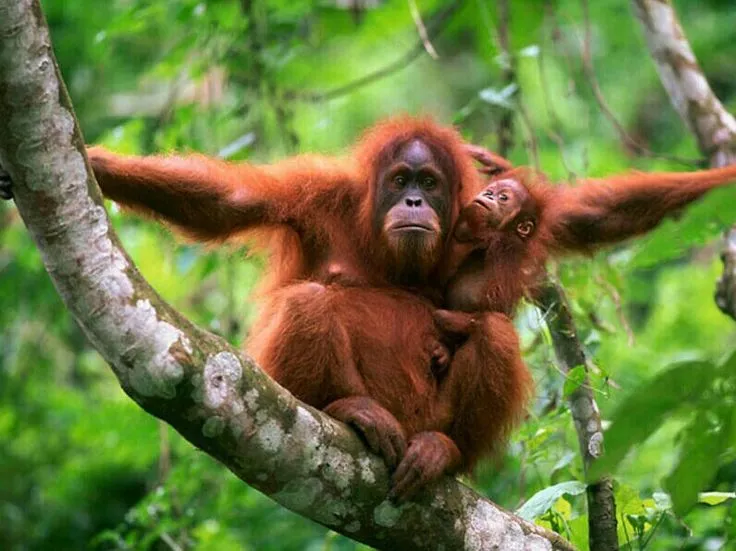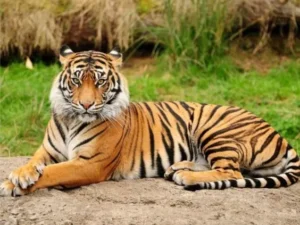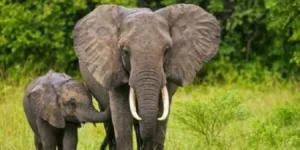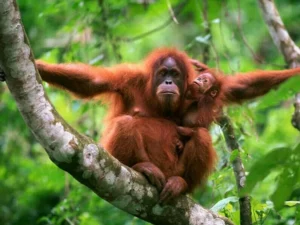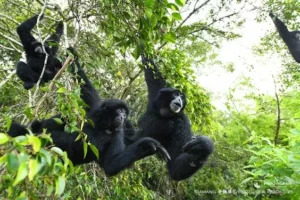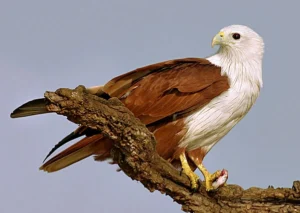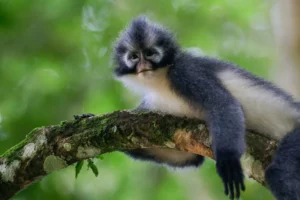Sumatra, an island rich in biodiversity, is home to various rare and unique fauna species. However, the beauty of this nature is not immune to the threats of extinction. This article will address 10 Indigenous Fauna of Sumatra facing a serious risk of extinction. By deeply understanding this situation, we can participate in urgent conservation efforts to preserve the remarkable sustainability of this ecosystem.
10 Indigenous Fauna of Sumatra
1.Sumatran Tiger
source : pinterest.com
The Sumatran Tiger (Panthera tigris sumatrae) is an example of the wonder of Indigenous Fauna of Sumatra that deserves preservation. As one of the smallest tiger species in the world, its size does not match its power and beauty. However, unfortunately, its natural habitat is diminishing due to rampant deforestation and illegal poaching threatening its survival. To address the growing risk of extinction, conservation programs focusing on preserving natural habitats and stricter law enforcement are necessary. These proactive measures are crucial to protect the Sumatran Tiger and maintain the biodiversity sustainability of this island.
By actively supporting the conservation and restoration of natural habitats, we can contribute to ensuring the future of the Sumatran Tiger and save its ecosystem from constantly evolving threats. Raising awareness among the population about the importance of preserving Sumatra’s Indigenous Fauna, such as the Sumatran Tiger, is also a crucial aspect of these preservation efforts. The more people are involved in conservation, the greater the chances of preventing the extinction of the Sumatran Tiger and taking care of the island’s natural beauty as a whole.
2.Sumatran Elephant
source : pinterest.com
The Sumatran Elephant (Elephas maximus sumatranus) represents the grandeur of Indigenous Fauna of Sumatra threatened with extinction. As a rare elephant species, they face serious risks due to habitat destruction and conflicts with humans. Ongoing deforestation reduces the living space of Sumatran elephants, while conflicts with humans increase due to competition for land and resources. As a result, the population of Sumatran elephants is decreasing dramatically, posing a profound challenge to the sustainability of this species.
To save Sumatran elephants, appropriate habitat preservation measures must be implemented. This includes efforts to restore the forest, restrictions on deforestation, and the creation of ecological corridors allowing elephants to move freely. Moreover, it is important to adopt a sustainable approach to manage conflicts between humans and elephants.
This includes developing mutually beneficial solutions, such as implementing environmentally friendly farming practices and building infrastructures that minimize the impact on natural habitats. Through these measures, we can provide effective protection for Sumatran elephants and ensure their survival against the increasing pressure from extinction threats.
3.Sumatran Orangutan
source : pinterest.com
The Sumatran Orangutan (Pongo abelii) is the majestic representation of the diversity of Indigenous Fauna of Sumatra facing a real threat. This large primate, found only on the island of Sumatra, feels the effects of logging and harmful poaching. The destruction of natural habitats due to human activity and illegal poaching has led to a dramatic decline in the population of Sumatran orangutans. To ensure the survival of this species and preserve the sustainability of the ecosystem, comprehensive and sustainable conservation efforts are needed.
Preserving natural habitats is a crucial step to protect the Sumatran orangutan. This involves the restoration of damaged forests, the creation of ecological corridors, and the implementation of measures to limit unsustainable logging. Additionally, a holistic approach also requires increased public awareness of the importance of preserving nature. Education and public awareness can empower local communities to become part of the solution, reducing conflicts with orangutans and supporting conservation efforts. With these joint efforts, we can restore the balance of Sumatra’s ecosystem and ensure the survival of Sumatran orangutans for future generations.
4.Sumatran Rhinoceros
source: siakapkeli.my
The Sumatran Rhinoceros (Dicerorhinus sumatrensis) represents the diversity of Indigenous Fauna of Sumatra and a small rhinoceros species threatened with extinction on the island. The main threats come from two major factors: illegal poaching and habitat loss due to human activity. Illegal poaching for the rhinoceros horn trade poses a direct threat to the survival of the Sumatran Rhinoceros, while habitat loss leads to population fragmentation and isolation, increasing the risk of extinction. To save the Sumatran Rhinoceros from the brink of extinction, strong global support is needed.
Improving law enforcement is a key measure in Sumatran Rhinoceros conservation efforts. This involves strict measures such as strengthening border controls, detecting illegal trade networks, and imposing heavier penalties for offenders. Additionally, intensive monitoring of Sumatran Rhinoceros populations is essential to understand population dynamics and identify potential threats.
Furthermore, the rehabilitation of degraded habitats is a crucial aspect to ensure that the Sumatran Rhinoceros has a suitable natural environment for breeding. With global support and joint efforts, we can preserve sustainability and protect the Sumatran Rhinoceros from the threat of extinction.
5.Malayan Sun Bear
The Malayan Sun Bear (Helarctos malayanus) represents the smallest bear species inhabiting the forests of Southeast Asia, including Sumatra. Despite its small size, the Malayan Sun Bear faces serious threats that could lead to extinction. These threats include illegal hunting, clandestine trade, and the ongoing destruction of habitat. To protect the sustainability of the Malayan Sun Bear population, concerted efforts in various areas are necessary.
Strict law enforcement is the key to combating illegal hunting and clandestine trade of Malayan Sun Bears. Strict measures against illegal hunters, as well as close monitoring of illegal trade, can help reduce pressure on the Malayan Sun Bear population. Additionally, habitat preservation is a significant priority to ensure that the Malayan Sun Bear has a healthy and sustainable natural environment.
Efforts to rehabilitate damaged forests and create ecological corridors are crucial measures to support the survival of the Malayan Sun Bear. Moreover, public education plays a vital role, increasing awareness of the importance of protecting this species and encouraging participation in conservation efforts. With these measures, we can ensure that the presence of the Malayan Sun Bear remains constant in the wild nature of Sumatra.
6.Siamang Gibbon
source : pinterest.com
The Siamang Gibbon (Symphalangus syndactylus) is part of the diversity of Indigenous Fauna of Sumatra, becoming a large monkey species that calls the island of Sumatra home, facing serious threats to its survival. Massive deforestation and illegal trade have created tremendous pressure on the siamang population, threatening to deprive them of their natural environment. In the effort to protect the siamang and maintain the sustainability of its population, coordinated and holistic conservation programs are needed.
Habitat recovery is the main priority to ensure the sustainability of the siamang. These measures include efforts to stop unsustainable deforestation and rehabilitate damaged forests. Strict law enforcement against the illegal trade of siamangs is also an important measure to reduce pressure on this population.
Moreover, increasing public awareness of the importance of siamang and habitat preservation is an integral part of conservation efforts. Education programs and awareness campaigns can mobilize the population to participate in preservation efforts, making them essential partners in protecting this unique wildlife. With these measures, we can collectively ensure the survival of the siamang in the wild nature of Sumatra and preserve the biodiversity of the island.
7.Brahminy Kite
source: attsumseltour.blogspot.com
The Brahminy Kite (Haliastur indus), a widely distributed eagle species in Southeast Asia, including the island of Sumatra, is currently facing serious threats to its survival. Disturbances to its natural habitat and illegal hunting have exerted significant pressure on the Brahminy Kite population, jeopardizing the sustainability of this species. To preserve the presence of the Brahminy Kite in the biological diversity of Sumatra, targeted and sustainable conservation efforts are needed.
An effective conservation program should focus on two main aspects: population monitoring and preservation of natural habitat. Accurate population monitoring can provide in-depth understanding of the dynamics of the Brahminy Kite population, allowing adjustments to conservation strategies based on changes that occur. Preserving natural habitat involves measures to protect areas that serve as a home for the Brahminy Kite, including efforts to restore habitat and create secure conservation zones.
Additionally, reducing human disturbances to the Brahminy Kite’s habitat, such as deforestation and harmful human activities, is also a priority to ensure the sustainability of this species. By uniting our efforts through a holistic conservation program, we can provide effective protection to the Brahminy Kite and preserve the precious natural heritage of the island of Sumatra.
8.Nias Hill Myna
source: 1001indonesia.net
The Nias Hill Myna (Gracula robusta) is one of the endemic bird species of Nias Island, in northern Sumatra, Indonesia, part of the native fauna diversity of Sumatra. With a relatively large size and colorful plumage, the Nias Hill Myna attracts attention for its aesthetic appeal. Measuring about 40 to 50 centimeters in length, with large eyes and a powerful beak, this bird not only captures visual attention but also has an exceptional vocal ability, capable of mimicking sounds from its environment and speaking.
The Nias Hill Myna is typically found in tropical forests, mountainous regions, and forest edges, reflecting its adaptation to diverse habitats. Threats to its survival include illegal hunting and deforestation. To protect the Nias Hill Myna and other species, key steps include preserving natural habitat, strict law enforcement, and increasing community awareness. Biodiversity, including the Nias Hill Myna, plays a crucial role in the ecosystem, and these collective efforts support the preservation of the biodiversity of Nias Island and Sumatra as a whole.
9.Sumatran Clouded Leopard
source: goodnewsfromindonesia.id
The Sumatran Clouded Leopard, as an integral part of Indigenous Fauna of Sumatra, dominates the tropical and subtropical forests of the island. Known for its smaller size and distinctive fur, this leopard plays a crucial ecological role as the primary predator, helping regulate the populations of prey such as deer, wild boars, and monkeys. However, their population is threatened by deforestation, leading to habitat loss and conflicts with humans. Conservation efforts have been deployed to protect the Sumatran Clouded Leopard, establishing protected areas and implementing habitat restoration programs to ensure the survival of this subspecies.
As part of Indigenous Fauna of Sumatra, the Sumatran Clouded Leopard plays a crucial ecological role in maintaining the balance of the forest ecosystem. This leopard contributes not only to controlling prey populations but also has a positive impact on the health of the forest. Although conservation efforts have been deployed to protect them from extinction, the challenges facing the Sumatran Clouded Leopard underscore the need for additional actions to preserve its natural habitat and manage conflicts with humans to ensure the subspecies’ survival in the future.
10.Kedih Monkey
source: mongabay.co.id
The Kedih (Presbytis thomasi) is a primate species inhabiting the northern region of Sumatra, Indonesia, belonging to the Cercopithecidae family. Its presence is closely linked to dry or subtropical tropical forests, making it a dependent endemic animal on its natural environment. In Aceh, this animal is known as “reungkah,” while in Alas, it is called “kedih.” Unfortunately, the existence of the Kedih is threatened by the ongoing destruction of its habitat. Deforestation of forests and human activities in the region result in a reduction of forested areas and lead to conflicts between this primate and human settlements.
Strong conservation efforts are needed to protect the Kedih and maintain the balance of the ecosystem in northern Sumatra. Concrete measures must be taken to protect its natural habitat, including the creation of conservation zones and educating local populations about the importance of environmental sustainability. Biodiversity, including the Kedih, plays a crucial role in the ecosystem, and these collective efforts support the preservation of the biodiversity of northern Sumatra and Sumatra as a whole.
Conclusion
Through a deep understanding of the challenges faced by Indigenous Fauna of Sumatra, we are called upon to collectively preserve the remarkable sustainability of this nature. Serious challenges such as deforestation, illegal hunting, and habitat loss place these rare species at real risk of extinction. To counter these threats, concrete measures must be taken immediately.
Through education and awareness campaigns, we can empower the community to become guardians of nature and actively participate in preservation efforts. Strong public support can encourage governments and conservation institutions to take additional measures and make nature preservation a major priority. By uniting these efforts, we can ensure that the natural beauty of Sumatra and the diversity of its Indigenous Fauna of Sumatra are eternal for future generations. Visit the diversity of Indigenous Fauna of Sumatra with our Hello Bali, and we are ready to help you plan your trip to Sumatra.

